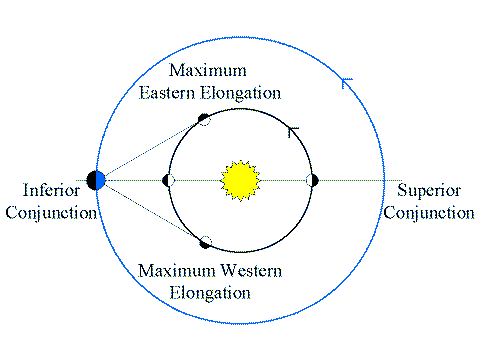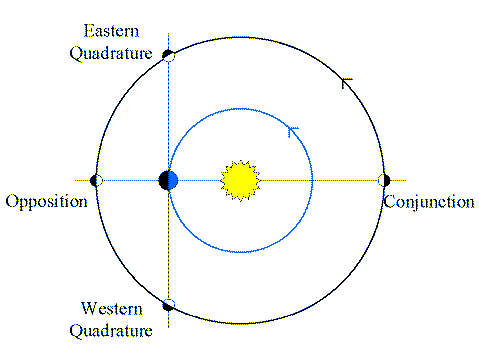Lecture 12: The Wanderers
Key Ideas
The Planets:
- "Wandering stars" that follow complex paths
near the Ecliptic.
Planetary Configurations:
- Inferior Planets
- Superior Planets
- Conjunction & Opposition
Retrograde Motion
More information on planets can be found here, retrograde motion here, conjunction here.
The Naked-Eye Sky
Celestial objects visible to the naked-eye include
- Sun:
- Bright disk ~1/2° across
- Moon:
- Pale disk ~1/2° across that goes through monthly phases.
- Stars:
- Pinpoints of light that appear fixed relative to each
other on the Celestial Sphere.
- Planets: (Greek: planetai = "wanderers")
- Points of light that move relative to the "fixed" stars.
- Stay within a few degrees of the Ecliptic
- Follow complex paths that take between 88d
(Mercury) and 30y (Saturn) to complete a
circuit through the Zodiac.
Five Classical Planets:
- Mercury, Venus, Mars, Jupiter, & Saturn
Inferior & Superior Planets
Early astronomers recognized that the 5 classical planets could be
divided into two groups:
Inferior Planets: Mercury & Venus
- Appear to follow the Sun across the sky.
- <28° for Mercury, and <47° for Venus.
Superior Planets: Mars, Jupiter, & Saturn
- All move along the Ecliptic on paths seemingly
independent of the motions of the Sun.
- All can appear in the sky any time (e.g., around midnight)
Inferior Planet Configurations

(Click on the image to view at full scale [Size:
9Kb])(Graphic by R. Pogge)
- Inferior Conjunction
- Planet is between the Earth and the Sun.
- Superior Conjunction
- Planet on the other side of the Sun from Earth.
During either conjunction, the inferior planet appears to rise and set
with the Sun.
Maximum Eastern Elongation
- Planet is at its furthest East of the Sun as seen
from the Earth (28° for Mercury, 47° for Venus)
- Rises & sets after the Sun ("evening
star")
Maximum Western Elongation
- Planet is at its furthest West of the Sun as seen
from the Earth (same angles as Eastern Elongation).
- Rises & sets before the Sun ("morning star")
Superior Planet Configurations

(Click on the image to view at full scale [Size:
9Kb])(Graphic by R. Pogge)
Opposition
- Planet is opposite the Sun in the sky.
- Rises as the Sun sets
- Highest in the sky at midnight.
Conjunction
- Planet is on the same side of the sky as the Sun.
- Rises with the Sun
- The planet does not appear in the the night sky.
Eastern Quadrature
- Planet at right angles to the Earth-Sun line.
- Planet rises at noon, sets at midnight.
Western Quadrature
- Planet at right angles to the Earth-Sun line.
- Planet rises at midnight, sets at noon.
Retrograde Motion
In general, the planets move eastward relative to the
"fixed" stars.
- Called "Direct Motion".
- Motion is non-uniform (not at the same speed).
Sometimes, however, the planets appear to
- Slow down & stop!
- Start moving westward, or RETROGRADE,
- Slow down & stop again,
- Resume moving eastward again.
[Click Here to see an image (16Kb) of the
retrograde motions of Mars during 1994/95 when it made a particularly
characteristic loop. A 688Kb QuickTime movie
shows this figure in motion (beware! it is a large file)]
(Graphic by R. Pogge)
Apparent retrograde motion is observed in all planets.
- Inferior Planets (Mercury & Venus):
- Undergo retrograde motion around inferior conjunction.
- Superior Planets (Mars, Jupiter, & Saturn):
- Undergo retrograde motion at around opposition.
In all cases the apparent paths followed by the planets as seen from
the Earth are very complex. They make various loops and S-curves during
their retrograde motions that are due to the tilts of their paths
relative to the Ecliptic.
[Click Here to see an montage (18Kb)
of the recent (1998-2000) retrograde motions of Mercury, Venus, Mars,
Jupiter, and Saturn. Note that Jupiter & Saturn, currently visible
after sunset high in the Eastern sky, are just now (Jan 18) ending a
period of retrograde motion that started back in October of last
year.](Graphic by R. Pogge)
Who Ordered That?
Unlike all of the other motions we've seen thus far, planetary
motions are dauntingly complex.
The struggle to understand these motions took nearly 3000 years:
- The motions are subtle and defy poetic or metaphorical description.
- Their complexity similarly defies simple geometric description.
Explaining planetary motions poses a formidable challenge to any theory
of the heavens.
A Question of Approach
How do we explain the motions of the planets?
Two approaches have been taken:
Phenomenological Description
- Find a way to compute the motions without worrying about the
details of why they work this way.
- Goal is to "preserve appearances" (i.e., make reliable predictions)
Physical Description
- Discover the underlying physical principles behind
the planetary motions (i.e., ask "why" they move).
- Predictions of the motions should then follow from first principles
From Myth to Science
Any satisfactory theory of planetary motions had to have the
following characteristics:
- Internal Consistency
- Must follow the same basic rules, no special cases or special
pleading is allowed.
- Predictive Power
- Must provide measurably accurate predictions of future behavior.
The effort to come up with a self-consistent, predictive theory of
planetary motions marks the true birth of science.
Updated: 2011 October 4, Todd A. Thompson
Copyright © Richard W. Pogge, All Rights
Reserved.

